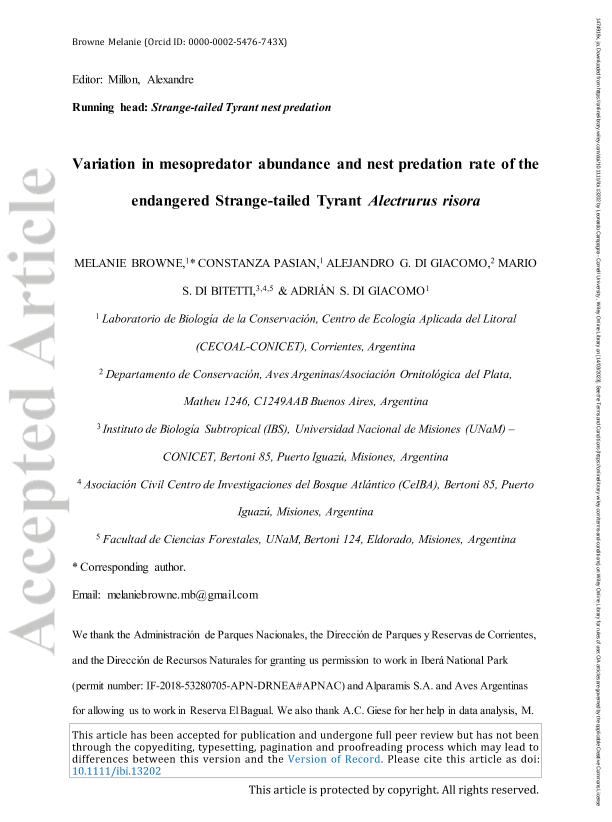Artículo
Variation in mesopredator abundance and nest predation rate of the endangered Strange‐tailed Tyrant Alectrurus risora
Browne, Melanie ; Pasian, Constanza
; Pasian, Constanza ; Di Giacomo, Alejandro G.; Di Bitetti, Mario Santiago
; Di Giacomo, Alejandro G.; Di Bitetti, Mario Santiago ; Di Giacomo, Adrian Santiago
; Di Giacomo, Adrian Santiago
 ; Pasian, Constanza
; Pasian, Constanza ; Di Giacomo, Alejandro G.; Di Bitetti, Mario Santiago
; Di Giacomo, Alejandro G.; Di Bitetti, Mario Santiago ; Di Giacomo, Adrian Santiago
; Di Giacomo, Adrian Santiago
Fecha de publicación:
03/2023
Editorial:
Wiley Blackwell Publishing, Inc
Revista:
Ibis
ISSN:
0019-1019
Idioma:
Inglés
Tipo de recurso:
Artículo publicado
Clasificación temática:
Resumen
Nest predation is the main cause of nest failure in passerine birds and thus is a key determinant of breeding traits. Accordingly, nest predator community composition and abundance modulate nest predation rates. When top predators are absent, mesopredator populations may become unchecked, which in turn increases the predation pressure on their prey species. We evaluated whether nest predator abundance and breeding traits of an endangered grassland bird, the Strange-tailed Tyrant Alectrurus risora, differed between two protected areas: Iberá National Park (INP), where top predators have been extinct for 50 years, and Reserva El Bagual (REB), where Pumas Puma concolor still have a stable population. We measured abundances of potential nest predator species and during the 2015–2018 breeding seasons we monitored Strange-tailed Tyrant nests and set camera traps to identify nest predators. Mesopredator abundance was higher in INP, and foxes were identified as the main nest predators. Nest predation rate was also higher in INP, where the daily nest predation rate and cumulative probability of nest predation were 0.05 ± 0.006 and 0.81, whereas in REB they were 0.04 ± 0.004 and 0.70, respectively. The 10-fold higher frequency of fox records in INP could explain the higher nest predation rate observed, suggesting that the extinction of top predators may increase nest predation rates of endangered grassland birds in protected areas through release of native mesopredator species. The lower nest predation observed in REB was compensated for by a higher nest abandonment rate, which resulted in a similar fledgling production in the two study sites. Clutch size, hatching success and number of nestlings did not differ between study sites. The low breeding success recorded for this endangered species despite its populations being in protected areas of high conservation value is alarming given the global decline that grassland bird populations are facing.
Archivos asociados
Licencia
Identificadores
Colecciones
Articulos(CECOAL)
Articulos de CENTRO DE ECOLOGIA APLICADA DEL LITORAL (I)
Articulos de CENTRO DE ECOLOGIA APLICADA DEL LITORAL (I)
Articulos(IBS)
Articulos de INSTITUTO DE BIOLOGIA SUBTROPICAL
Articulos de INSTITUTO DE BIOLOGIA SUBTROPICAL
Citación
Browne, Melanie; Pasian, Constanza; Di Giacomo, Alejandro G.; Di Bitetti, Mario Santiago; Di Giacomo, Adrian Santiago; Variation in mesopredator abundance and nest predation rate of the endangered Strange‐tailed Tyrant Alectrurus risora; Wiley Blackwell Publishing, Inc; Ibis; 165; 4; 3-2023; 1201-1216
Compartir
Altmétricas



